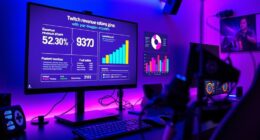If you’re looking to elevate your photos, I recommend exploring some of the best photography lighting technique handbooks. Tools like the *Set Lighting Technicians Handbook*, *The Off-Camera Flash Handbook*, and *Nikon Speedlight Handbook* offer detailed insights into creating perfect light setups, whether in studio or on location. The *National Geographic Photo Basics* and *Understanding Photography* give solid foundations, while guides on HDRI and controllable lighting expand your creative options. Keep exploring these resources to turn your lighting skills into a true art form.
Key Takeaways
- Evaluate handbooks that cover a wide range of lighting setups, techniques, and equipment for comprehensive learning.
- Prioritize resources that include practical tutorials, real-world examples, and step-by-step guides to enhance application skills.
- Choose books suitable for your skill level, from beginner guides to advanced technical references.
- Consider the focus on current technology, such as LED lighting, wireless triggers, and HDR workflows, for relevance.
- Review potential limitations like complexity or outdated info to ensure the handbook matches your specific lighting needs.
Set Lighting Technicians Handbook
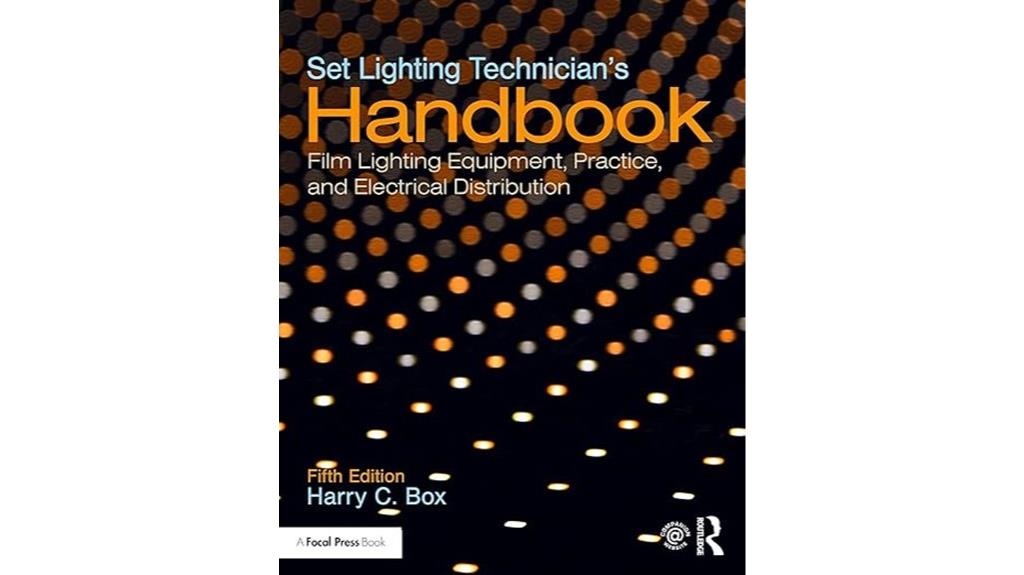
Are you looking for a complete guide that bridges technical knowledge and practical skills in film and TV lighting? The Set Lighting Technicians Handbook is exactly that. It’s a thorough resource covering everything from lighting setup and electricity to DMX systems and cutting-edge LED technology. With over 650 pages of detailed schematics, explanations, and industry insights, it’s an invaluable reference for both beginners and seasoned professionals. The book’s clear organization and current content make complex concepts accessible, helping you understand the “why” behind lighting techniques. Whether on set or in study, this handbook elevates your understanding and skills in modern cinematography lighting.
Best For: aspiring and experienced film and TV lighting technicians seeking a comprehensive, detailed reference to enhance their technical skills and practical knowledge.
Pros:
- Extensive coverage of lighting setup, electrical systems, DMX configuration, and LED technology.
- Well-organized, clear explanations that make complex concepts accessible.
- Over 650 pages of detailed schematics, technical data, and industry insights, making it a thorough resource.
Cons:
- Some images are black-and-white or photocopy-like, which may affect visual clarity.
- Packaging and presentation issues can make it less appealing as a physical product.
- The detailed technical focus may be overwhelming for complete beginners without prior background.
The Off-Camera Flash Handbook
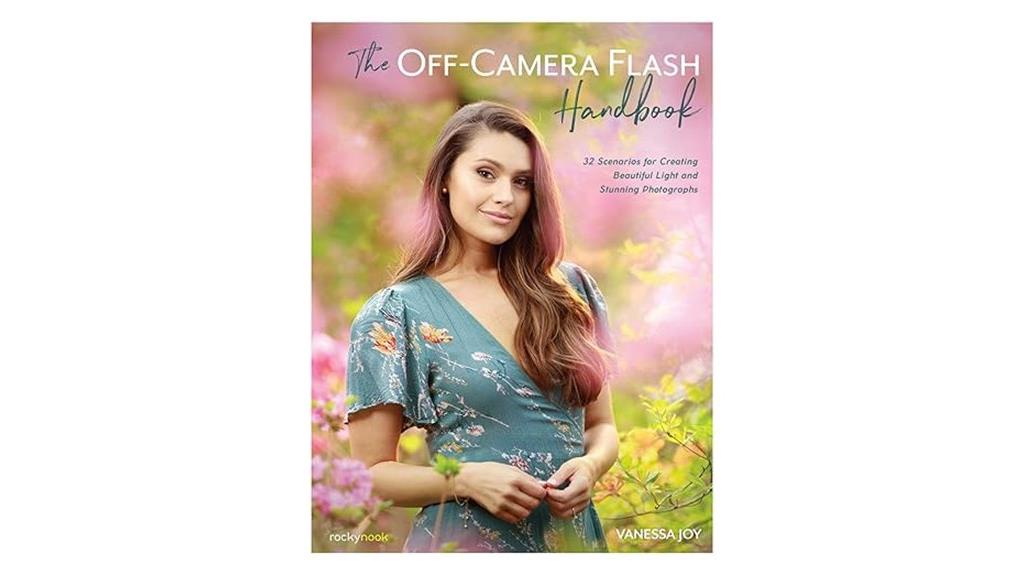
The Off-Camera Flash Handbook by Vanessa Joy is an excellent resource for beginner to intermediate photographers enthusiastic to master off-camera flash techniques. I found it incredibly practical, with clear step-by-step guides, behind-the-scenes images, and real-world scenarios. Vanessa’s engaging style makes complex concepts accessible, emphasizing hands-on practice. The book covers 32 lighting scenarios, helping me understand how to create different moods and effects on location. I appreciate her unbiased gear suggestions and the focus on practical application over theory. This book boosted my confidence, making flash photography less intimidating and more enjoyable, especially for wedding and event shoots.
Best For: beginner to intermediate photographers eager to learn practical off-camera flash techniques, especially those interested in wedding and event photography.
Pros:
- Clear, step-by-step guidance with behind-the-scenes images and real-world scenarios
- Engaging, accessible teaching style that simplifies complex concepts
- Practical focus on hands-on experimentation and application
Cons:
- Somewhat repetitive with similar scenarios, which may be less beneficial for advanced users
- Gear recommendations are mainly Canon-centric, requiring adaptation for other brands
- Focused more on wedding and event settings, less detailed for studio or commercial work
Nikon Speedlight Handbook: Flash Techniques for Digital Photographers

If you’re a Nikon user new to off-camera flash, *Nikon Speedlight Handbook: Flash Techniques for Digital Photographers* is an excellent starting point. It offers clear, step-by-step tutorials, practical guidance, and detailed images that make complex flash techniques accessible. The book covers various Nikon Speedlight models, explaining features and settings to help you understand how to use them creatively. Its straightforward language and organized structure boost confidence in manipulating light for both studio and on-location shoots. While it primarily focuses on current models, it provides valuable insights into off-camera flash fundamentals, making it an essential resource for beginners enthusiastic to elevate their photography with flash techniques.
Best For: Nikon beginners and amateur photographers seeking a clear, practical guide to off-camera flash techniques to improve their lighting skills.
Pros:
- Well-organized with step-by-step tutorials and detailed images for easy understanding
- Clear, straightforward language making complex flash concepts accessible
- Focuses on current Nikon Speedlight models, providing practical system knowledge
Cons:
- Does not cover older flashes like the SB-800, which may limit some users
- Primarily geared toward beginners and amateurs, less suitable for advanced or professional studio work
- Kindle formatting issues can occasionally hinder readability over images and headings
National Geographic Photo Basics Guide
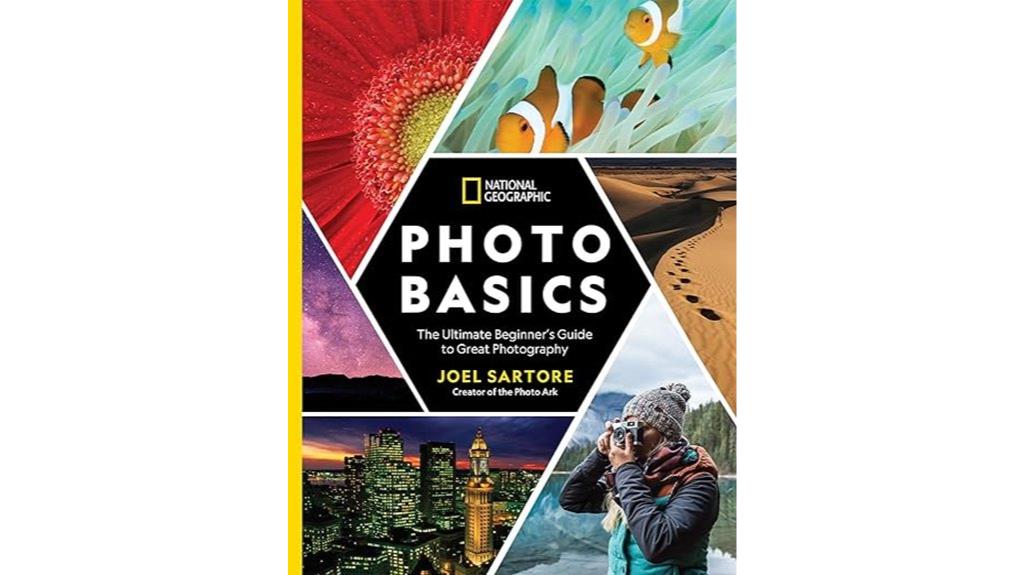
For beginners enthusiastic to build a solid foundation in photography, the National Geographic Photo Basics Guide offers an excellent starting point. I found its clear, easy-to-follow structure makes learning accessible and enjoyable. The book covers essential concepts with practical advice, tips, and engaging illustrations that clarify ideas. Its ten short chapters with exercises allow for gradual progress and easy review. While it focuses on creative techniques rather than technical details like exposure settings, it provides enough knowledge to start experimenting confidently. Many readers, including myself, feel it boosts creativity and builds foundational skills, making it a valuable resource for self-study or initial learning.
Best For: beginners who want a clear, accessible introduction to photography fundamentals and creative techniques to develop their skills confidently.
Pros:
- User-friendly and easy-to-follow structure suitable for self-study
- Includes engaging illustrations and example photos to clarify concepts
- Focuses on practical, creative techniques that boost confidence and inspire exploration
Cons:
- Offers limited in-depth coverage of technical topics like exposure settings and post-processing
- Designed primarily for beginners, may lack advanced or specialized content
- Some users may prefer more comprehensive or detailed technical explanations
Understanding Photography
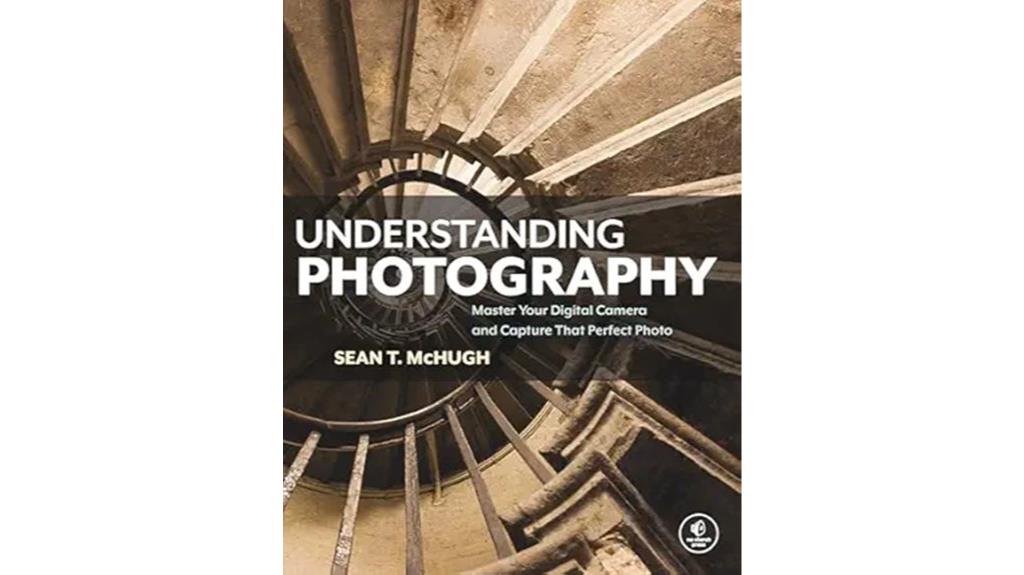
Are you looking to move beyond basic snapshots and develop a deeper understanding of how photography works? This book is perfect for both beginners and experienced shooters. It offers a clear, balanced mix of technical details and practical insights, helping you master camera mechanics, exposure, and creative techniques. I focus on making complex concepts accessible, using visuals and real-world examples to clarify ideas. Whether troubleshooting exposure issues or exploring artistic composition, you’ll find valuable tips and explanations. It’s more than a manual—it’s a guide to transforming your photos into meaningful, impactful images. This foundation empowers you to experiment confidently and elevate your craft.
Best For: beginners seeking a comprehensive introduction to digital photography as well as experienced photographers aiming to deepen their technical knowledge and artistic skills.
Pros:
- Balances technical detail with accessible explanations, suitable for all skill levels
- Richly illustrated with photographs, diagrams, and graphics to enhance understanding
- Offers practical tips and techniques to improve both technical execution and creative expression
Cons:
- May contain minor physical imperfections as noted by some readers
- Could be overwhelming for absolute beginners without prior exposure to basic concepts
- The depth of content might require dedicated study to fully absorb advanced topics
Speedliters Handbook: Learning to Craft Light with Canon Speedlites
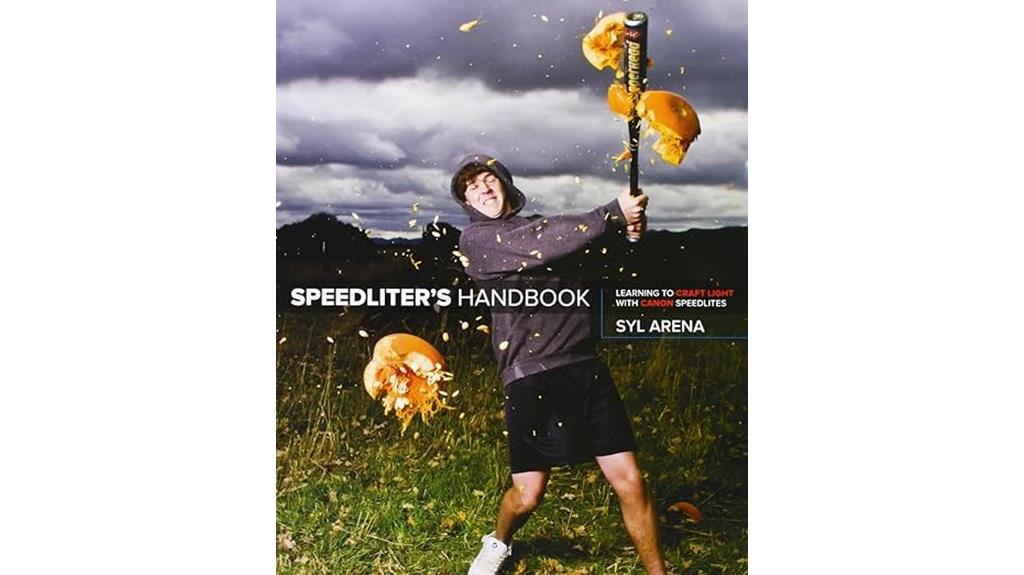
The “Speedliters Handbook” by Syl Arena stands out as an essential resource for Canon users enthusiastic to master flash lighting, whether they’re beginners or seasoned professionals. I find it incredibly practical, offering clear explanations of equipment, techniques, and lighting principles. The book guides you step-by-step through off-camera flash setups, modifiers, and creative lighting effects, making complex concepts accessible. Syl Arena’s friendly tone feels like having an expert buddy by your side, helping you understand how to control and shape light for stunning portraits, reportage, or studio shots. It’s a thorough manual that boosts confidence and inspires experimentation with Canon Speedlites.
Best For: Canon photographers of all levels seeking a comprehensive, practical guide to mastering flash lighting with Speedlites.
Pros:
- Clear, approachable explanations making complex lighting techniques accessible
- Extensive coverage of equipment, modifiers, and creative applications tailored for Canon Speedlites
- Step-by-step tutorials and practical tips that build confidence and inspire experimentation
Cons:
- Occasional minor editing glitches and superficial glossary entries
- Some equipment recommendations may become outdated as new gear is released
- The focus is primarily on Canon systems, limiting direct applicability to other brands
Nikon Creative Lighting System with SB Flashes

Photographers aiming to master off-camera lighting will find the Nikon Creative Lighting System (CLS) with SB flashes an invaluable tool. The system includes models like SB-600, SB-700, SB-800, SB-900, SB-910, and R1C1, offering wireless control over multiple flashes. It’s versatile for weddings, portraits, and studio work, allowing creative setups. While compatibility is generally consistent across Nikon DSLR models, newer flashes introduce slight differences in functions. Learning to use CLS effectively involves understanding flash modes, synchronization, and accessories like gels. Many guides provide practical tips, step-by-step instructions, and real-world examples, making complex lighting techniques accessible for beginners and intermediates alike.
Best For: photographers of all levels seeking to master off-camera lighting with versatile wireless control using Nikon CLS and SB flashes.
Pros:
- Enables seamless wireless control of multiple flashes, enhancing creative lighting setups
- Compatible with a wide range of Nikon DSLR models and flashes from SB-600 to SB-910
- Provides practical guidance with real-world examples and visual aids for both beginners and intermediates
Cons:
- Some guides may have superficial coverage of newer models like SB-910, leading to gaps in detailed features
- Repetitive instructions and limited updates in second editions can reduce usability
- Technical inaccuracies and lack of in-depth explanations for advanced features like high-speed sync
Lighting Techniques for High Key Portrait Photography

If you’re new to high key portrait photography and want straightforward guidance on lighting techniques, this chapter offers practical insights to get you started. I’ve found that understanding light ratios and digital enhancements can help you create clean, bright images with minimal fuss. However, be aware that many sample photos in this book are overexposed or outdated, which can be frustrating. Still, the explanations of how to achieve high key lighting and control overexposure are useful for beginners. Just keep in mind that some examples might not reflect the latest styles or professional standards, so supplement your learning with current photography resources.
Best For: Beginner photographers seeking straightforward guidance on high key portrait lighting techniques and digital enhancement concepts.
Pros:
- Clear explanations of light ratios and exposure control suitable for beginners
- Contains numerous images that can inspire and illustrate basic concepts
- Helpful for understanding foundational lighting techniques without complex jargon
Cons:
- Many sample photos are overexposed, amateurish, or outdated, reducing educational value
- Content can be repetitive and limited in practical, modern lighting setup details
- Not ideal for advanced or professional photographers seeking current, high-quality examples
Wildlife Photography Workshop, The

Wildlife Photography Workshop, The is an excellent resource for beginners and enthusiasts enthusiastic to learn foundational lighting techniques. Richly illustrated and easy to follow, it explains step-by-step concepts, making it perfect for those starting out in wildlife photography. Ross Hoddinott’s clear communication helps you grasp basic ideas like aperture and shutter speed, though it doesn’t explore into advanced wildlife-specific techniques. The book’s stunning images and practical approach make it a valuable gift for birdwatchers and novice photographers. While it’s ideal for beginners, more experienced shooters might find it lacks some technical depth, but it still offers a solid foundation to elevate your shots.
Best For: beginner and amateur wildlife photographers looking for a clear, visually appealing introduction to foundational photography techniques.
Pros:
- Richly illustrated with stunning images, making concepts engaging and easy to understand
- Step-by-step explanations ideal for those new to wildlife photography
- Clear communication from Ross Hoddinott enhances learning experience
Cons:
- Lacks advanced wildlife-specific techniques like 3D tracking and focus lock
- Provides only basic technical concepts, not in-depth technical guidance
- More suitable for beginners; less comprehensive for experienced photographers seeking advanced skills
Digital Photographers Handbook
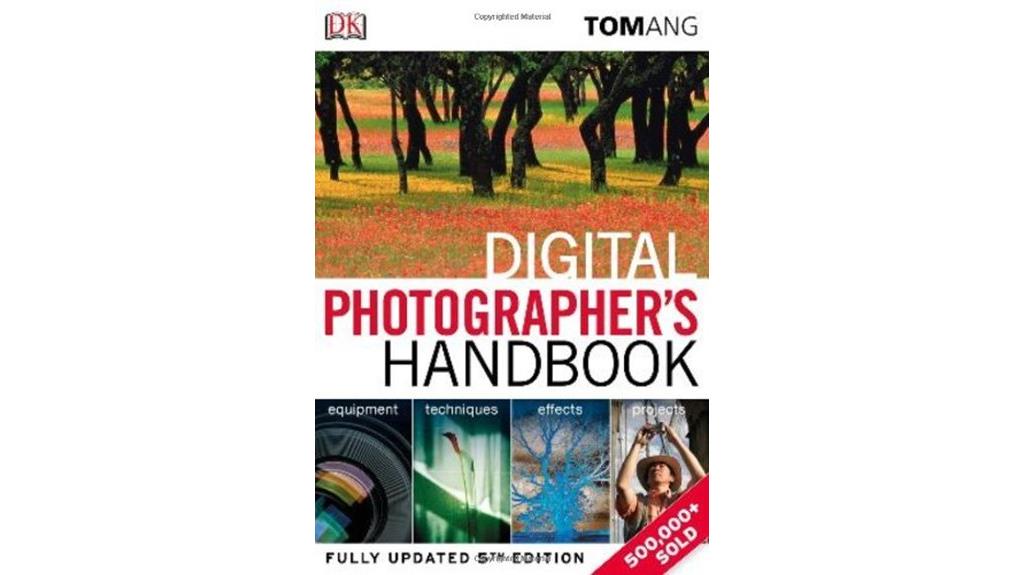
The “Digital Photographers Handbook” stands out as an ideal resource for beginners and intermediate enthusiasts keen to master lighting techniques. I find it highly recommended across all skill levels thanks to its clear, accessible language and detailed explanations. It covers essential skills like camera settings, composition, and various photography styles, including portraits, landscapes, and street photography. The book also dives into image development and post-processing, offering practical tips on editing software. Its all-encompassing approach makes it perfect for learning how to use lighting effectively, whether you’re just starting out or looking to refine your skills. Overall, it’s a versatile guide that elevates your photographic understanding.
Best For: Beginners and intermediate photographers eager to learn lighting techniques and improve their overall photographic skills.
Pros:
- Clear, accessible language suitable for all skill levels
- Comprehensive coverage of camera settings, composition, and styles
- Useful practical tips on image development and post-processing
Cons:
- Less focused on advanced photographic techniques
- Some readers may find the photos inappropriate or less relevant
- Online resources might offer more up-to-date or complete information
Understanding and Controlling Strobe Lighting: A Guide for Digital Photographers
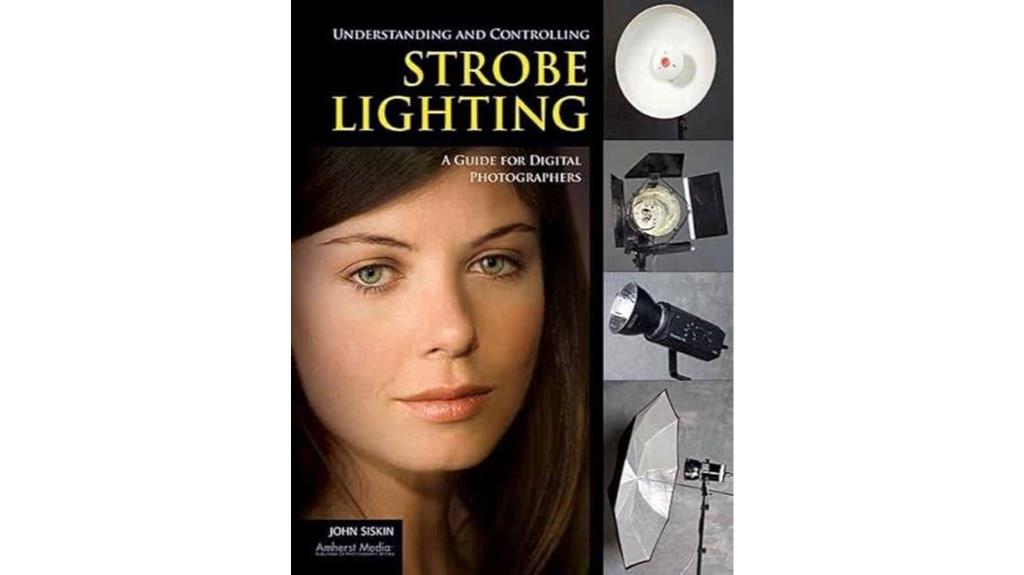
For digital photographers enthusiastic to master lighting control, understanding and controlling strobe lighting is essential. This guide helps you grasp how to manipulate light direction, intensity, and quality using strobes, softboxes, umbrellas, and filters. I emphasize experimenting with different setups and equipment to achieve your desired effects across portraits, product shots, and architecture. DIY solutions and budget-friendly options make advanced techniques accessible. By learning light behavior and modifications, you’ll enhance your creative control and storytelling. This practical approach guarantees you can confidently use off-camera lighting to elevate your images, regardless of your experience level.
Best For: beginner to intermediate digital photographers eager to understand and control strobe lighting to improve their portraits, product photography, and creative lighting setups.
Pros:
- Clear, accessible explanations that make complex lighting concepts easy to grasp
- Practical tips and DIY solutions suitable for budget-conscious photographers
- Comprehensive coverage of equipment, modifiers, and techniques to enhance creative control
Cons:
- Some images in the Kindle version may have lower production quality
- Lacks detailed camera and flash settings in example setups
- Might benefit from more advanced or professional lighting scenarios for experienced shooters
HDRI Handbook 2.0: High Dynamic Range Imaging Guide

If you’re seeking an all-encompassing resource that bridges theory and practical application in HDR imaging, the HDRI Handbook 2.0 is an excellent choice. I found it invaluable for understanding HDRI’s significance in digital imaging, showing how it transforms difficult scenes into stunning images. The book covers technical foundations like merging exposures, tone mapping, and software options, with clear tutorials and practical tips. Christian Bloch’s insights help demystify complex concepts, making them accessible. Plus, the included resources and guides make it a must-have for photographers, CGI artists, and filmmakers aiming to elevate their lighting techniques with high dynamic range imagery.
Best For: photographers, CGI artists, and filmmakers seeking a comprehensive guide to HDRI techniques, workflow, and software applications.
Pros:
- Thorough coverage of both theory and practical application, making complex concepts accessible
- Detailed tutorials, step-by-step guides, and practical examples enhance learning and implementation
- Includes valuable resources such as software, sample images, and open-source projects on the accompanying DVD
Cons:
- Slightly outdated software and operating system details may require supplementary updates
- Technical content may be challenging for absolute beginners without prior digital imaging knowledge
- Limited language options and potential resource omissions in digital versions might affect accessibility
The HDRI Handbook for Photographers and CG Artists +DVD

Anyone serious about mastering high dynamic range imaging will find *The HDRI Handbook for Photographers and CG Artists +DVD* an invaluable resource. It offers a thorough introduction to HDR concepts, including dynamic range, exposure, and human perception, making complex topics accessible. The book details various file formats, software tools, and workflows for capturing, editing, and tone mapping HDR images. With practical tips, real-world examples, and a supporting DVD, it encourages experimentation and skill development. While some sections are technical, the overall approach is educational, helping photographers and CG artists elevate their images through a deeper understanding of HDR techniques.
Best For: photographers and CG artists seeking a comprehensive, educational guide to mastering HDR imaging, including capture, editing, and creative applications.
Pros:
- Thorough coverage of HDR concepts, techniques, and workflows suitable for various skill levels
- Includes practical tips, real-world examples, and a DVD with software trials for hands-on learning
- Well-structured, making complex topics accessible and encouraging experimentation
Cons:
- Some sections are highly technical, which may be challenging for beginners
- Occasional technical inaccuracies and vague explanations noted by some readers
- The detailed content can be dense, potentially overwhelming for those seeking quick, simple instructions
Factors to Consider When Choosing Photography Lighting Technique Handbooks

When selecting a lighting technique handbook, I focus on how well it matches my skill level and whether the content is clear and detailed enough for my needs. I also consider if it covers the equipment I use and keeps up with current industry trends, including practical examples that I can apply. Ultimately, choosing the right resource means finding a balance between thoroughness and accessibility that helps me improve my craft.
Skill Level Compatibility
Choosing a photography lighting technique handbook that matches your skill level is essential for effective learning. If you’re a beginner, look for books that cover foundational concepts and use simple language to avoid confusion. Intermediate or advanced photographers should seek handbooks with more complex techniques and detailed explanations to challenge themselves and grow. Check if the content aligns with what you already know and your specific goals—whether mastering basic lighting setups or exploring advanced studio techniques. Practical exercises tailored to your proficiency level help reinforce skills and build confidence gradually. Also, ensure the book offers a clear progression path, so you can develop your skills step-by-step as your expertise increases. This alignment prevents frustration and maximizes your learning potential.
Content Depth and Clarity
Selecting a photography lighting handbook that offers the right level of content depth and clarity can make a significant difference in your learning process. A well-balanced guide provides enough technical detail to deepen your understanding while remaining accessible. It should cover fundamental principles, advanced techniques, and practical applications to grow with your skills. Clear organization and logical progression help you build knowledge step-by-step, preventing confusion. Visual aids like diagrams, example images, and detailed instructions make complex lighting setups easier to grasp. Additionally, precise language and well-defined terminology are essential, ensuring you understand nuanced concepts without misinterpretation. Overall, a handbook that combines depth with clarity keeps you engaged and confident as you master different lighting techniques.
Equipment and Technology Focus
Focusing on equipment and technology is essential when evaluating photography lighting handbooks because the right tools and systems directly impact the quality and efficiency of your lighting setups. These guides often detail various lighting tools like strobes, speedlights, softboxes, and modifiers, explaining their functions and settings. They include technical insights into how devices operate, covering aspects like power output, color temperature, and control mechanisms such as DMX or TTL systems. Modern lighting technology, including LED panels, wireless triggers, and digital controls, is also emphasized to guarantee compatibility and maximum use. Practical setup diagrams and troubleshooting tips tailored to specific hardware help streamline your workflow. Ultimately, understanding the technical specs of your gear enables you to achieve creative effects reliably across different shooting scenarios.
Visual and Practical Examples
When exploring photography lighting handbooks, the inclusion of high-quality visual and practical examples makes a significant difference. These examples vividly illustrate different lighting setups and their effects, helping you grasp complex concepts more easily. Step-by-step diagrams and before-and-after images demonstrate how specific adjustments influence the final shot, making technical details more accessible. A diverse range of images—portraits, still life, environmental shots—exposes you to various scenarios and creative approaches. Clear visual references help you understand lighting placement, modifiers, and camera settings, encouraging hands-on experimentation. Well-curated examples not only inspire but also serve as concrete benchmarks, deepening your understanding of how technical choices translate into artistic results. These visual tools are essential for practical learning and mastery.
Up-to-Date Industry Trends
Have you ever wondered if your photography lighting handbook is keeping up with the latest industry advancements? It’s essential to select guides that reflect current practices and equipment, especially as technology evolves rapidly. Modern handbooks incorporate innovations like LED lighting, wireless triggers, and high-dynamic-range imaging, making sure your skills stay relevant. Staying informed about these trends helps you adapt to new styles, techniques, and aesthetic preferences emerging in the industry. The best guides also include updated best practices for off-camera lighting, modifiers, and digital post-processing. Regularly refreshed handbooks prevent reliance on outdated methods, ensuring you learn techniques that are widely accepted and effective today. This keeps your work fresh, professional, and aligned with current industry standards.
Frequently Asked Questions
Which Lighting Handbook Is Best for Beginner Photographers?
If you’re a beginner, I recommend “Lighting for Photographers” by Scott Kelby. It’s clear, easy to understand, and packed with practical tips that help you grasp the basics quickly. I found his explanations straightforward, making it perfect for someone just starting out. Plus, the book covers different lighting setups and techniques, so you can experiment confidently and improve your shots right away.
How Do I Choose Between Natural and Artificial Lighting Guides?
Choosing between natural and artificial lighting guides is like picking the right paint for a canvas. I once tried a natural light guide during a sunset shoot, which transformed my photos with warm, soft hues. Then I explored artificial lighting for studio portraits, giving me control over every shadow. I recommend picking a guide suited to your style—natural for outdoors, artificial for controlled environments—so your shots always tell your story.
Are These Handbooks Suitable for Portrait, Landscape, or Wildlife Photography?
These handbooks are versatile and cover lighting techniques suitable for portrait, landscape, and wildlife photography. I’ve found that they offer practical advice for different settings, whether you’re working with natural light for landscapes, studio setups for portraits, or outdoor conditions for wildlife. They help me adapt lighting to various subjects, making my shots look more professional and compelling. If you want to elevate your photography, these guides are definitely worth exploring.
Do These Books Cover Studio and On-Location Lighting Techniques?
Yes, these books cover both studio and on-location lighting techniques. I used them to improve my portraits and outdoor shots, and they give clear, practical advice for any environment. If you’re worried they’re only for studio setups, don’t be—these handbooks guide you through portable lighting gear and natural light use, making it easy to elevate your photography whether you’re indoors or out in the field.
Can These Handbooks Help Improve My Post-Processing Lighting Adjustments?
Absolutely, these handbooks can help improve your post-processing lighting adjustments. I’ve found that they not only teach you how to light scenes effectively but also give you a solid understanding of how to enhance those shots during editing. They cover techniques for adjusting brightness, contrast, and color balance, empowering you to refine your images and achieve professional-looking results after the shoot.
Conclusion
Exploring these handbooks opens up a world of lighting possibilities. While mastering each technique takes time, embracing the journey will gently enhance your skills and confidence. Remember, even the most seasoned photographers started somewhere, and every step forward brings new insights. So, keep experimenting and enjoying the process—your perfect shot is just a light tweak away. With patience and curiosity, you’ll find your unique style shining through every frame.







